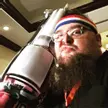Google's Highest Resolution OLED for VR HMDs Rumored for a May Reveal, Besting Rift and Vive Specs
The tech giant is getting ready to blow the competition out of the water with tech specs far beyond those of the Vive and Oculus.
If rumors are to be believed, it looks like Google, in partnership with Sharp, will soon be pushing VR into a brand new realm of vivid picture clarity. Last year at the Society for Information Display’s 2017 conference Clay Bavor the head of Google VR/AR announced his team was working on a "secret" project. It's now believed that secret project was a brand-new HD OLED VR glass display that will be announced in May.

Currently, the highest end VR headsets on the consumer market have a 2-megapixel resolution per eye with roughly a 110° field of view. The secret Google OLED should sport 10 times the resolution and more than double the field of view of current standard displays on 2.5 x 4K displays. According to 9 to 5 Google, this year's advance program for the Information Display Conference states that it will reveal an "18 megapixel 4.3-inch OLED display with 'wide-field-of-view.' Meanwhile, a 1443 PPI is touted with a 120-Hz refresh rate."
Right now some are speculating that the display will have a resolution of 5500 x 3000, which blows the HTC
If the rumors of Google's new display are true, it should be getting a reveal on May 22. No one is quite sure what this will mean for
-
Blake Morse posted a new article, Google's Highest Resolution OLED for VR HMDs Rumored for a May Reveal, Besting Rift and Vive Specs
-
-
current techniques can drop it 4-5x, with some proposed ones citing 5-10x but needing quality problems around stability solved first. https://www.youtube.com/watch?v=gV42w573jGA
If you don't assume the current render pipeline (e.g. allowing for things like path-tracing) it could even go further, but thats likely a decade away.-
-
I went to a talk last week about eye tracking, it's very cheap now.
Most supermarkets have eye tracking cameras above each shelf and watch consumers as they browse. Their eye movements are used to charge suppliers more for certain shelf positions.
The project I'm working on is using them with tiny kids to diagnose autism. You clip a cheap eye tracker to the top of a monitor, then watch while an 18-month-old kid views a video. The video shows a dog walking to the left, then a duck to the right, then a cat to the left again. As new objects appear, kids somewhere on the spectrum take noticeably longer to switch attention. Interesting!
I suppose real-time eye tracking is still expensive. I think these cheap ones just use a simple IR camera and detect the face and the pupil later via software analysis of the video.-
Real time accurate stuff is, yeah - I have a friend whose son has brain damage from birth so he has very little control of his limbs and limited capabilities just, 5 years ago they paid 5000 gbp for a tracker equivalent to the 300usd tobii today. (and it actually opened up his life a lot - able to play games and switch between activities on his own whim for the first time). That price drop was just due to cheaper IR CCDs, once they are mass produced as a unit I expect it could get down to $10 on a BoM.
-
-
-
-
That would be an incredible jump in fidelity. Even if current hardware couldn't drive native resolutions it would still be a huge win to render at half resolution and upscale the results. It seems to me that a big reason text isn't very readable in VR right now isn't because of the actual resolution but more because of the screen door effect making it difficult to put letters together.
Of course when hardware catches up and can run at native res then that'll be all that much better.
-


